By Jeffrey A. Rendall, Photos by Jeffrey A. Rendall
WILLIAMSBURG – There’s an old saying that goes, ‘Nothing in life that’s worthwhile is ever easy,’ which has certainly been proven true in nearly every instance, even if we’d all prefer a path that’s simple and satisfying without much sweat and toil.
The saying proved veritable once again in talking about the Yorktown Course at Williamsburg National, a fine Ault, Clark & Associates designed layout that nicely compliments the facility’s first golf course (the Jamestown Course), inspired by Nicklaus Design Associates.
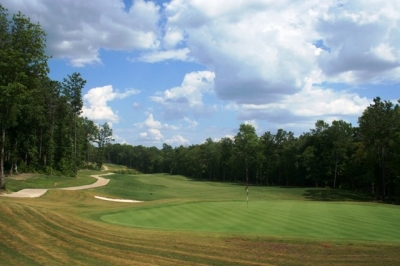 |
| From behind the green of the par five 3rd hole, you'll witness the beauty that is the Yorktown Course. |
It turns out the Yorktown Course was always in Williamsburg National’s plans, but time and circumstances led to a lengthy delay in giving the go ahead to construct it, and then some production delays put it back even further. It was a difficult journey to completion for the Yorktown, but in the end, like the old saying – it was worth it.
Course designer Tom Clark provides the background to the dilemma: “It’s a long story, but all thirty-six holes at Williamsburg National were originally laid out by Nicklaus Design (Jim Lipe was the project manager), but only eighteen were developed in the beginning. That course opened in 1995. In 2002, Lewis Waltrip (who was part of the group that developed the neighborhood surrounding the property) bought the golf course and retained ownership of the remaining developable land.”
Waltrip went about selling parcels of the land with the caveat that the second course would be built within a certain period of time after – it was just a question of ‘when,’ not ‘if.’
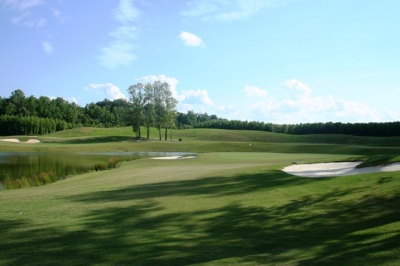 |
| The long par five 16th hole is rated the back nine's toughest hole - and with a green surrounded by trouble on three sides, you'll quickly understand why. |
Even prior to that, back in 2000, Waltrip had asked Clark to design a few holes to provide a ‘preview’ of what the new course would look like, and a local developer built them after Clark produced some rough concept sketches. Clark says around 2004, he met with Waltrip on several occasions to discuss the possible alternatives for completion of the second course, and Ault/Clark was hired (after a competitive interviewing process) to complete the design work.
Since the second eighteen holes had already been laid out, you’d think the Yorktown Course would’ve been well on its way to fruition, once the go ahead was given to begin the work. Wrong, Clark explained. “A firm had already been hired to do the storm water management and erosion sedimentation plans based on the original Nicklaus layout – but there’d been so many changes to the wetland and environmental regulations since 1995, that we basically had to start over.”
“Wetlands wasn’t even a word we were familiar with back then,” Clark mused. “Wetlands are sometimes difficult to work around because they tend to push the golf towards the housing – and of course, the homeowners don’t want to give up the housing. Luckily, wetlands are only an issue on a few holes at Williamsburg National, such as off the tee on the (par five) third hole.”
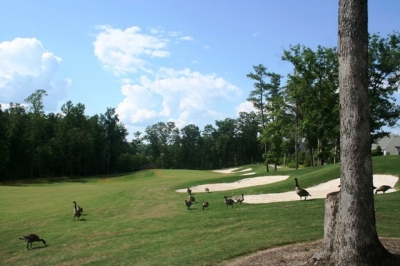 |
| Turning the corner on the par four 6th hole - bunkers (and geese) stand ready to catch any shot hit through the dogleg off the tee. |
Clark said there were also some unanticipated delays with their first golf course construction contractor and clearing issues. For example, the site clearing was done at the wettest time of the year, which led to an excessive amount of cleanup and ended up throwing the project behind schedule – and also led to a change in project contractors.
“After a six month delay, Aspen Construction (of Aspen, West Virginia) came in to complete the work and did an excellent job in the areas they were assigned,” Clark added. Another firm, Personal Property Management (out of Suffolk, Virginia) then came in to supplement the final cleanup and grow-in.
And the Yorktown Course finally opened in late 2007.
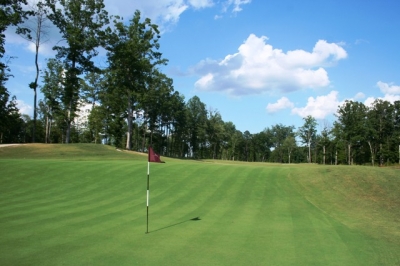 |
| The green of the par three 14th hole features two terraces - and in this shot, the pin is set on the much more difficult lower level. |
Being the second golf course on site, Clark felt it was important that the Yorktown Course not only rival, but hopefully surpass the Jamestown Course in playing quality. “I’d worked in the Williamsburg area a fair amount before (on the Woods Course at Kingsmill, and the Golf Club at Brickshire, to name a few), and we wanted to create a championship layout that would also be enjoyable for resort players of all types.”
Challenging and playable don’t always go together, and the site’s heavily wooded and eroded clay topsoil meant there was much work to be done in routing the course properly. There were also numerous wetland areas to mitigate and even perennial streams with RPA’s (Resource Protection Areas) which added to the challenge in formulating the golf holes.
But perhaps the biggest challenge involved making the course stand out from its Williamsburg National sibling, designed by the venerable Nicklaus team. Mission accomplished – and while both are enjoyable, playable resort courses, the Yorktown Course is probably more aesthetically pleasing.
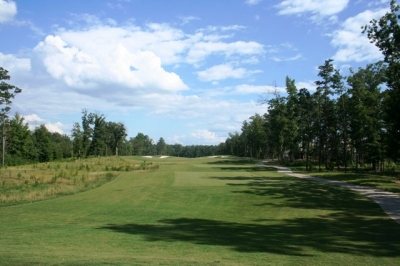 |
| You'll know exactly what you have to do off the tee of the par five 9th hole - just as you will for every tee shot on the Yorktown Course. |
Clark tells how it was done: “In order to make the course different from the Jamestown layout, I conceived a routing with a mixture of very long and short par threes, fours and fives. I also went to square and rectangular tee box designs, jagged bunkers and diverse streams, which included a Biarritz and Redan.”
“Finally, the back nine features three par threes, fours and fives,” Clark concluded.
Spoken like a true golf architect, but you’d need a golf dictionary to know what a ‘Biarritz’ means… or a ‘Redan’ for that matter.
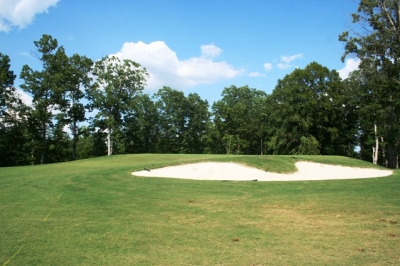 |
| The par four 11th hole is relatively short at 330-yards, but the green is on a plateau - you'll earn your birdie opportunity if you get one. |
Again, Clark provides the clues: “‘Biarritz’ and ‘Redan’ refer to the work of (classic architects) Charles Blair Macdonald and Seth Raynor, who picked some of their favorite holes over in Ireland and Scotland and England and ‘brought’ them to America – concepts like the punchbowl green, where anything you hit up towards the green will be channeled towards it.”
Clark continues, “On the Yorktown Course, I put a ‘Biarritz’ (a green with a low center section and higher sides) on the fourth hole – a distinct depression in the middle of the green with higher sides on the right and left.”
A ‘Redan’ is just like the military term – a built-up section of earth that will repel objects. In this case, Clark says there’s a ‘Redan’ built into the left side of the second hole, a long par four. The higher left side is meant to steer balls hit to that side towards the green, which allows a player to play a shot away from the bunkers on that hole.
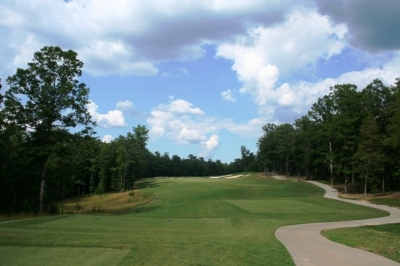 |
| The bunkers in view off the tee of the par four 5th hole appear to squeeze the landing area, but you should be able to go over them without much problem. |
One other prominent Clark-inspired architectural feature is the green of the fourteenth hole. From the tee, it appears like the Yorktown’s largest lake is just over the back of the putting surface – and in one case, it is. There are two distinct terraces to the green, including a steep drop-off to a lower surface at the upper-right.
When you play it, you might wonder why such an odd feature would be incorporated into a green. “The backwards terrace on the fourteenth hole was originally done as kind of a novelty, but then we literally wanted to bring the water into play on that hole. The water’s too far in back of the green to influence play on the front part of the green, so we found a way to bring it into play for a hole that shoots right towards the big lake,” Clark explained.
The lake also figures prominently on the par five sixteenth and the par three seventeenth holes – another slice of variety on a course that contains quite a lot of variation for a piece of land that wouldn’t add it naturally.
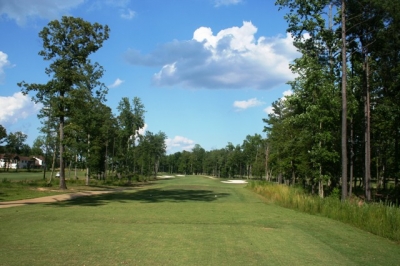 |
| The long and difficult par four 15th hole has one of the tightest tee shots on the course. |
Steve Beecroft, Williamsburg National’s Head Golf Professional, also points to the variety you’ll find on the Yorktown Course. “It’s hard to believe that the Yorktown and Jamestown courses share the same acreage, because they’re both very different. The Yorktown Course actually has a fair amount of elevation changes, especially on the front nine. When you combine that with the unique three par threes, fours and fives on the back side, it’s never boring.”
Beecroft shares in Clark’s opinion as to the overall playability of the course, with five sets of tees to apportion the challenge accordingly. But no matter the distance, Beecroft says it’s the sand that defines the course. I asked him what makes the Yorktown Course challenging, and he answered “the bunkers, the bunkers, the bunkers and then the water. Clark did a great job of positioning the bunkers so you have to think a little on each shot in terms of what you want to try to do.”
And, as alluded to above, although the course is lined by trees on many of the holes (or houses in some instances), it’s still friendly to the sideways-challenged occasional player. “I’d like players to take most of their golf balls home with them when they leave,” Beecroft joked. Fortunately, Clark provides more than adequate playing space on the course – and even if you hit it in the trees, there’s still a reasonable chance you’ll find the ball in most cases (because of the clearing).
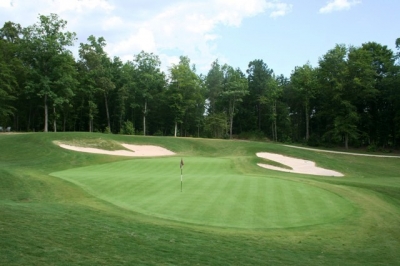 |
| The green of the par three 4th hole features a 'Biarritz' - a depression in the center and elevated spots on the left and right sides. |
The Yorktown’s greens complexes are also tightly mowed, providing chipping areas – yet another aspect that helps the high handicappers while challenging better players to use their imaginations to get the ball up and down.
In addition to the other holes described above, our favorites included the short par four fifth hole. From the tee, the landing area looks very narrow – but Clark says it’s an illusion, since the visible bunkers require only about 160 yards to carry them. Guard against going left here, however, as any ball hit to that side will roll down a hill and leave you in a not-so-desirable spot (as I found out).
The back side features another terrific short par four, the 330-yard (from the back tees) eleventh hole. It’s one of those holes that begs you to get as close as you can off the tee – but if you miss, the consequences could be severe. There’s out-of-bounds on the right and the green is on a plateau with steep bunkers protecting it.
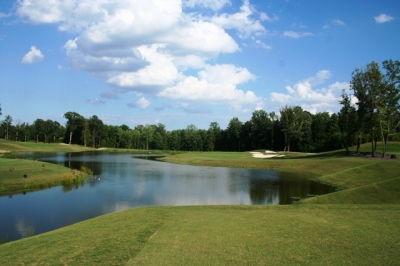 |
| You can't see it from this view, but the par three 17th hole's green is 75 yards long - better pay attention to the pin placement on the tee sheet. |
The par three seventeenth hole plays alongside the lake and features a green that’s 75 yards in length – pay attention to the pin sheet and choose your club accordingly!
Beecroft sums up the Yorktown Course experience: “I hope players feel challenged without being beat up by the golf course. The Yorktown’s definitely a thinking golf course that rewards good decisions and good shots. After playing it, I hope our guests realize how much it takes to play the game of golf and that they experienced every shot making ability they possess and also what they may need to work on.”
Without a doubt, Williamsburg National’s Yorktown Course was well worth all the work it took to create it, which proves once again that worthwhile effort often comes with a healthy dose of satisfaction.
Details:
3700 Centerville Road
Williamsburg, VA 23188
Phone: 800-859-9182; 757-258-9642;
FAX: (757) 258-9738
Website: http://www.wngc.com/
Course Designer: Tom Clark
Head Golf Professional: Steve Beecroft, PGA
Tees/Yardage/Slope/Rating
Black 6953 133/72.9
Blue 6411 123/70.8
White 5900 121/68.4
Green 5105 110/65.2
Ladies:
White 5900 132/73.6
Green 5105 118/68.8
Rates:
$79 March through November; $65 December through February.
Twilight rates are available.
Visit the Website for package information.
| Related Links | Comments on this article? | |
|
Maryland National Golf Club Hollow Creek Golf Club Rocky Gap Resort PB Dye Golf Club in Ijamsville Whiskey Creek Golf Club |
E-mail Jeff Rendall, Editor: jrendall@golftheunitedstates.com |











